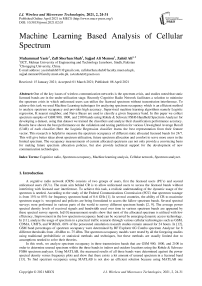Machine Learning Based Analysis of Cellular Spectrum
Автор: Muhammad Yasir, Zafi Sherhan Shah, Sajjad Ali Memon, Zahid Ali
Журнал: International Journal of Wireless and Microwave Technologies @ijwmt
Статья в выпуске: 2 Vol.11, 2021 года.
Бесплатный доступ
One of the key issues of wireless communication networks is the spectrum crisis, and studies noted that static licensed bands are in the under-utilization stage. Recently Cognitive Radio Network facilitates a solution to minimize the spectrum crisis in which unlicensed users can utilize the licensed spectrum without transmission interference. To achieve this task we used Machine Learning techniques for analyzing spectrum occupancy which is an efficient method to analyze spectrum occupancy and provides high accuracy. Supervised machine learning algorithms namely Logistic regression, K nearest neighbor, and Naive Bayes are used to classify a given frequency band. In this paper we collect spectrum samples of GSM 900, 1800, and 2100 bands using Rohde & Schwarz FSH6 Handheld Spectrum Analyzer for developing a dataset, using that dataset we trained the classifiers and analyze their classification performance accuracy. Results have shown the best performance on the validation and testing partition for various Unweighted Average Recall (UAR) of each classifier. Here the Logistic Regression classifier learns the best representation from their feature vector. This research is helpful to measure the spectrum occupancy of different static allocated licensed bands for 24/7. This will give better ideas about spectrum utilization, future spectrum allocation and comfort to serve more users in the limited spectrum. The occupancy measurements of current allocated spectrums can not only provide a convincing basis for making future spectrum allocation policies, but also provide technical support for the development of new communication technologies.
Cognitive radio, Spectrum occupancy, Machine learning analysis, Cellular network, Spectrum analyzer
Короткий адрес: https://sciup.org/15017671
IDR: 15017671 | DOI: 10.5815/ijwmt.2021.02.03
Список литературы Machine Learning Based Analysis of Cellular Spectrum
- S. Ali, Z. Chen, and F. Yin, “Spectrum Occupancy of Cellular Networks in Pakistan for Cognitive Radio — Measurements using Spectrum Analyzer,” Int. J. Inf. Electron. Eng., vol. 6, no. 1, pp. 26–31, 2015.
- M. J. Marcus, “Spectrum policy for radio spectrum access,” Proc. IEEE, vol. 100, no. SPL CONTENT, pp. 1685–1691, 2012.
- V. Valenta, Z. Fedra, R. Maršálek, G. Baudoin, and M. Villegas, “Analysis of spectrum utilization in suburb environment - Evaluation of potentials for cognitive radio,” 2009 Int. Conf. Ultra Mod. Telecommun. Work., no. 2008, pp. 0–5, 2009.
- M. Lopez-Benitez and F. Casadevall, “Space-Dimension Models of Spectrum Usage for Cognitive Radio Networks,” IEEE Trans. Veh. Technol., vol. 66, no. 1, pp. 306–320, 2017.
- M. Wellens and P. Mähönen, “Lessons learned from an extensive spectrum occupancy measurement campaign and a stochastic duty cycle model,” Mob. Networks Appl., vol. 15, no. 3, pp. 461–474, 2010.
- R. I. C. Chiang, G. B. Rowe, and K. W. Sowerby, “A quantitative analysis of spectral occupancy measurements for cognitive radio,” IEEE Veh. Technol. Conf., pp. 3016–3020, 2007.
- S. W. Ellingson, “Spectral occupancy at VHF: Implications for frequency-agile cognitive radios,” IEEE Veh. Technol. Conf., vol. 2, pp. 1379–1382, 2005.
- J. Do, D. M. Akos, and P. K. Enge, “L and S bands spectrum survey in the San Francisco Bay area,” Rec. - IEEE PLANS, Position Locat. Navig. Symp., pp. 566–572, 2004.
- F. H. Sanders, “Broadband spectrum surveys in Denver, CO, San Diego, CA and Los Angeles, CA: Methodology, analysis, and comparative results,” IEEE Int. Symp. Electromagn. Compact., vol. 2, pp. 988–993, 1998.
- J. Xue, Z. Feng, and P. Zhang, “Spectrum Occupancy Measurements and Analysis in Beijing,” IERI Procedia, vol. 4, pp. 295–302, 2013.
- P. K. Dalela, A. Nayak, V. Tyagi, and K. Sridhara, “Analysis of spectrum utilization for existing cellular technologies in context to cognitive radio,” 2011 2nd Int. Conf. Comput. Commun. Technol. ICCCT-2011, pp. 585–588, 2011.
- B. K. Engiz and Y. A. Rajab, “Investigation of spectrum occupancy in GSM band in Samsun, Turkey,” Proc. - 2019 6th Int. Conf. Electr. Electron. Eng. ICEEE 2019, pp. 158–161, 2019.
- A. A. Mirani, S. A. Memon, S. Hussain, M. A. Panhwar, and S. R. A. Shah, “Spectrum occupancy measurement of the cellular spectrum and smart network sharing in Pakistan,” Int. J. Adv. Comput. Sci. Appl., vol. 11, no. 3, pp. 232–243, 2020.
- F. Azmat, Y. Chen, and N. Stocks, “Analysis of spectrum occupancy using machine learning algorithms,” IEEE Trans. Veh. Technol., vol. 65, no. 9, pp. 6853–6860, 2016.
- A. Agarwal, A. S. Sengar, and R. Gangopadhyay, “Spectrum Occupancy Prediction for Realistic Traffic Scenarios: Time Series versus Learning-Based Models,” J. Commun. Inf. Networks, vol. 3, no. 2, pp. 44–51, 2018.
- H. Anandakumar and K. Umamaheswari, “Supervised machine learning techniques in cognitive radio networks during cooperative spectrum handovers,” Cluster Comput., vol. 20, no. 2, pp. 1505–1515, 2017.
- A. Agarwal, S. Dubey, M. A. Khan, R. Gangopadhyay, and S. Debnath, “Learning-based primary user activity prediction in cognitive radio networks for efficient dynamic spectrum access,” 2016 Int. Conf. Signal Process. Commun. SPCOM 2016, 2016.
- S. T. Gul, A. U. Omer, and A. Majid, “Machine learning techniques for wideband spectrum sensing in cognitive radio networks,” Networks Futur. Archit. Technol. Implementations, vol. 31, no. 11, pp. 43–68, 2017.
- M. Maalouf, “Logistic regression in data analysis: An overview,” Int. J. Data Anal. Tech. Strategy., vol. 3, no. 3, pp. 281–299, 2011.
- M. Wasilewska and H. Bogucka, “Machine learning for LTE energy detection performance improvement,” Sensors (Switzerland), vol. 19, no. 19, 2019.
- A. K. Mishra and P. Vijaykumar, “Analysis of spectrum occupancy using naïve Bayesian classifier,” Int. J. Recent Technol. Eng., vol. 7, no. 4, pp. 115–117, 2018.


